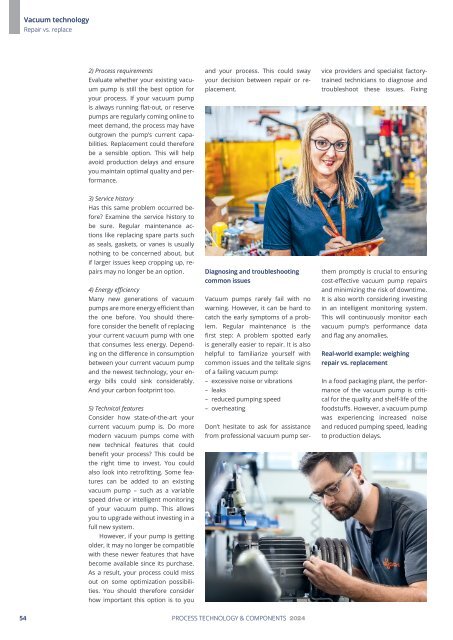PuK - Process Technology & Components 2024
A technical trade magazine with a history of more than 60 years.
A technical trade magazine with a history of more than 60 years.
Create successful ePaper yourself
Turn your PDF publications into a flip-book with our unique Google optimized e-Paper software.
Vacuum technology<br />
Repair vs. replace<br />
2) <strong>Process</strong> requirements<br />
Evaluate whether your existing vacuum<br />
pump is still the best option for<br />
your process. If your vacuum pump<br />
is always running flat-out, or reserve<br />
pumps are regularly coming online to<br />
meet demand, the process may have<br />
outgrown the pump’s current capabilities.<br />
Replacement could therefore<br />
be a sensible option. This will help<br />
avoid production delays and ensure<br />
you maintain optimal quality and performance.<br />
and your process. This could sway<br />
your decision between repair or replacement.<br />
vice providers and specialist factorytrained<br />
technicians to diagnose and<br />
troubleshoot these issues. Fixing<br />
3) Service history<br />
Has this same problem occurred before?<br />
Examine the service history to<br />
be sure. Regular maintenance actions<br />
like replacing spare parts such<br />
as seals, gaskets, or vanes is usually<br />
nothing to be concerned about, but<br />
if larger issues keep cropping up, repairs<br />
may no longer be an option.<br />
4) Energy efficiency<br />
Many new generations of vacuum<br />
pumps are more energy efficient than<br />
the one before. You should therefore<br />
consider the benefit of replacing<br />
your current vacuum pump with one<br />
that consumes less energy. Depending<br />
on the difference in consumption<br />
between your current vacuum pump<br />
and the newest technology, your energy<br />
bills could sink considerably.<br />
And your carbon footprint too.<br />
5) Technical features<br />
Consider how state-of-the-art your<br />
current vacuum pump is. Do more<br />
modern vacuum pumps come with<br />
new technical features that could<br />
benefit your process? This could be<br />
the right time to invest. You could<br />
also look into retrofitting. Some features<br />
can be added to an existing<br />
vacu um pump – such as a variable<br />
speed drive or intelligent monitoring<br />
of your vacuum pump. This allows<br />
you to upgrade without investing in a<br />
full new system.<br />
However, if your pump is getting<br />
older, it may no longer be compatible<br />
with these newer features that have<br />
become available since its purchase.<br />
As a result, your process could miss<br />
out on some optimization possibilities.<br />
You should therefore consider<br />
how important this option is to you<br />
Diagnosing and troubleshooting<br />
common issues<br />
Vacuum pumps rarely fail with no<br />
warning. However, it can be hard to<br />
catch the early symptoms of a problem.<br />
Regular maintenance is the<br />
first step: A problem spotted early<br />
is g enerally easier to repair. It is also<br />
helpful to familiarize yourself with<br />
common issues and the telltale signs<br />
of a failing vacuum pump:<br />
– excessive noise or vibrations<br />
– leaks<br />
– reduced pumping speed<br />
– overheating<br />
Don’t hesitate to ask for assistance<br />
from professional vacuum pump serthem<br />
promptly is crucial to ensuring<br />
cost-effective vacuum pump repairs<br />
and minimizing the risk of downtime.<br />
It is also worth considering investing<br />
in an intelligent monitoring system.<br />
This will continuously monitor each<br />
vacuum pump’s performance data<br />
and flag any anomalies.<br />
Real-world example: weighing<br />
repair vs. replacement<br />
In a food packaging plant, the performance<br />
of the vacuum pump is critical<br />
for the quality and shelf-life of the<br />
foodstuffs. However, a vacuum pump<br />
was experiencing increased noise<br />
and reduced pumping speed, leading<br />
to production delays.<br />
54 PROCESS TECHNOLOGY & COMPONENTS <strong>2024</strong>

















